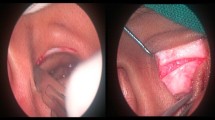Abstract
Objectives
To evaluate and compare functional outcomes of tympanoplasty procedures with temporalis fascia and four different types of cartilage grafts in chronic otitis media (COM) cases with normal preoperative hearing levels.
Methods
Records of patients who underwent type 1 tympanoplasty for non-complicated COM in a tertiary medical center between January 2010 and January 2017 were reviewed. Patients with central or marginal and dry perforations of the tympanic membrane, normal middle ear mucosa, intact ossicular chain and patients with a preoperative pure tone average (PTA) level of 25 dB or less and a word recognition score (WRS) of 88% or greater were included in the study. Graft success rates, preoperative and postoperative functional outcomes, and anatomical results were analyzed.
Results
One hundred and forty-four patients who met the inclusion criteria were evaluated in the study. PTA and Air-bone gap (ABG) levels decreased significantly both in TF and CG groups after the surgery (p = 0.001). Similarly, WRS scores increased significantly in both groups (p = 0.001). There was not a significant difference in terms of PTA increase, WRS increase, and ABG closure levels between cartilage and TF groups. Increase in PTA, closure in ABG, and increase in WRS levels were compared among TF, WsCCG, MCG, PCG, and CPIG groups. The increase in PTA levels was also found to be significantly superior in the TF group (p = 0,023). However, the multivariate analysis showed no significant difference for increase in WRS, closure in ABG and increase in PTA levels according to graft type (p = 0.285; p = 0.461; p = 0.106, respectively) and gender (p = 0.487; p = 0.811; p = 0.756, respectively).
Conclusion
In COM cases with normal preoperative hearing, both TF and cartilage lead to superb functional and anatomical outcomes. There was not a significant difference in terms of PTA increase, WRS increase and ABG closure levels between cartilage and TF groups. The graft success rate of cartilage was found to be superior to TF, but there was not a statistically significant difference. Different types of cartilage grafts can be used in cases with normal preoperative hearing without the concern of hearing impairment.
Similar content being viewed by others
References
Wullstein HL (1952) Funktionelle operationen im Mettelohr mit hilfe des freien spaltlappen transplantates. Archotorhinolaryngology 161:422–443
Dornhoffer J (2003) Cartilage tympanoplasty: indications, techniques, and outcomes in a 1,000-patient series. Laryngoscope 113:1844–1856
Gerber MJ, Mason JC, Lampert PR (2000) Hearing results after primary cartilage tympanoplasty. Laryngoscope 110:1994–1999
Callioglu EE, Ceylan BT, Kuran G, Demirci S, Tulaci KG, Caylan R (2013) Cartilage graft or fascia in tympanoplasty in patients with low middle ear risk index (anatomical and audiological results). Eur Arch Otorhinolaryngol 270:2833–2837
Mohamad SH, Khan I, Hussain SS (2012) Is Cartilage tympanoplasty more effective than fascia tympanoplasty? A systematic review. Otol Neurotol 33:699–705
Kazikdas CK, Onal K, Boyraz I, Karabulut E (2007) Palisade cartilage tympanoplasty for management of subtotal perforations: a comparison with the temporalis fascia technique. Eur Arch Otorhinolaryngol 264:985–989
Committee on Hearing and Equilibrium (1995) Guidelines for the evaluation of results of treatment of conductive hearing loss. Otolaryngol Head Neck Surg 113:186–187
Gurgel RK, Jackler RK, Dobie RA, Popelka GR (2012) A new standardized format for reporting hearing outcome in clinical trials. Otolaryngol Head Neck Surg 147:803–807
Kartush JM, Michaelides EM, Becvarovski Z, LaRouere MJ (2002) Over-under tympanoplasty. Laryngoscope 112:802–807
Heermann J (1962) The author’s experience of using free temporalis fascia and the cartilage bridge from stapes to tympanic membrane for tympanoplasty and the reduction of radical mastoid cavity. Zeitschrift fur Laryngologie Rhinologie Otologie 41:141–155 [article in German]
Kim JY, Oh JH, Lee HH (2012) Fascia versus cartilage graft in type I tympanoplasty: audiological outcome. J Craniofac Surg 23:605–608
Iacovou E, Vlastarakos PV, Panagiotakopoulou A, Chrysostomou M, Kandiloros D, Adamopoulos G, Ferekidis E (2012) The effect of type I tympanoplasty on the resonant frequency of the middle ear: comparison between chondrotympanoplasty and temporalis fascia grafting. J Otolaryngol Head Neck Surg 41:14–19
Zahnert T, Huttenbrink KB, Murbe D, Bornitz M (2000) Experimental investigations of the use of cartilage in tympanic membrane reconstruction. Am J Otol 21:322–328
Huttenbrink KB (1997) Mechanical aspects of middle ear reconstruction. In: Huttenbrink KB (ed) Middle ear mechanics in research and otosurgery. Department of Oto-Rhino-Laryngology Press, Dresden, pp 165–169
Mürbe D, Zahnert T, Bornitz M, Huttenbrink KB (2002) Acoustic properties of different cartilage reconstruction techniques of the tympanic membrane. Laryngoscope 112:1769–1776
Yilmaz MS, Guven M, Kayabasoglu G, Varli AF (2015) Comparison of the anatomic and hearing outcomes of cartilage type 1 tympanoplasty in pediatric and adult patients. Eur Arch Otorhinolaryngol 272:557–562
Funding
The research received no specific grant from any funding agency in the public, commercial, or not-for-profit sectors.
Author information
Authors and Affiliations
Corresponding author
Ethics declarations
Conflict of interest
The authors declare that they have no conflict of interest.
Rights and permissions
About this article
Cite this article
Balcı, M.K., İşlek, A. & Ciğer, E. Does cartilage tympanoplasty impair hearing in patients with normal preoperative hearing? A comparison of different techniques. Eur Arch Otorhinolaryngol 276, 673–677 (2019). https://doi.org/10.1007/s00405-018-5262-3
Received:
Accepted:
Published:
Issue Date:
DOI: https://doi.org/10.1007/s00405-018-5262-3




